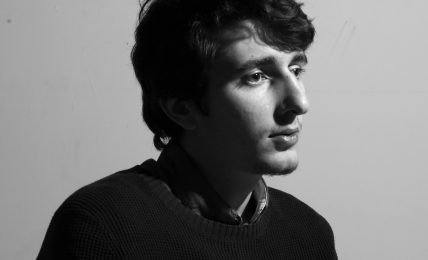Daniel Alexander Smith is a visual artist based in Cambridge, MA. In 2016, he completed an MFA Fellowship at Indiana University. In 2015, he founded Paper-Thin, an online virtual reality art archive, which he currently directs and curates with collaborator, Cameron Buckley. In 2014, he curated Beyond Mapplethorpe, part of a collection of exhibits supported by The Robert Mapplethorpe Foundation and the Kinsey Institute.
Daniel’s artwork has been exhibited nationally and internationally at venues including Boston Cyberarts, the Indianapolis Museum of Art, the CICA Museum in Gyeonggi-do, South Korea, the Festival Internacional de Linguagem Eletronica in São Paulo, Brazil, the Athens Digital Arts Festival in Athens, Greece, the University of Notre Dame, the Carnegie Arts Center in Cincinnati, and the Center for Fine Art Photography in Ft. Collins. His recent works include Unfixed Architecture, a large, multi-channel video commission for the Boston Convention and Exhibition Center Marquee; Four and No Waves, an installation addressing how computers re-frame relationships with nature; and Poly_Count, a collection of machine-made drawings exploring representation as a technological abstraction.
Digital America is currently featuring Daniel Alexander Smith’s two pieces, Sea Change and Tide, as part of the Crooked Data: (Mis)information in Contemporary Art [site no longer live] exhibition at the University of Richmond Museums. You can view these pieces here.
:::
DigA: You describe the digital environment in Sea Change as an “alien asymptote,” which suggests that there is an aspect of the terrain that is never approaching completion. Can you elaborate on using the concept of an asymptote in your work?
DAS: Asymptotes mark holes in mathematical functions, which collapse the infinite to the finite. They’re only resolved by bending the Cartesian plane to a sphere. In this regard the geometry of Sea Change is analogous to an asymptote. It marks a dimensional shift. The video exists in an irrational space. Natural is flattened into digital, collapsing dimensionality until space dissolves entirely. What interests me about asymptotes is that they represent a space that is unreachable, but surpassable. For a less abstract example, you can’t add up the infinite series ½ + ¼ + 1/8 + 1/16 + etc… What is remarkable, is that you know it adds to 1. I see analogous processes occurring culturally and technologically. Continuous technological change transforms the natural world once mechanically, now digitally. There was no defined moment of change, but somehow we are past the moment.
DigA: There are many levels of data creation and manipulation in Sea Change. Filming the water transferred the moving image into data, and then those images were further quantified as the data of each wave was modeled and manipulated. You note that the mathematical model stripped the waves of context and character. Do you see all forms of digital copying a devaluing of context and character, including digital video?
DAS: I think all representation strips away character—whether digitally copied or hand drawn. Digital replication is just faster and more precise. Representations have never recalled the character of originals–they present something altogether different. A digital wave exists because of an absurdly complex design, whereas wind and water exist just because. The tricky thing is that technology has proliferated so many images of such elaborate realism that you begin to have more associations with images than originals. Digital copying doesn’t devalue context and character, it arbitrarily reassigns value.
DigA: As we were first experiencing the work, we stumbled upon the audio. It was a pleasant surprise that enhanced our interpretation. How was the audio for Sea Change and Tide created? Do you see it as a critical aspect of the work?
DAS: Yes it’s critical. The audio shifts from rowing to synthetic clicking, and it peaks occasionally, forming literal asymptotes in the audio data. It’s intended to mirror the visual transformation. The key difference is the narration. The phrase “Sea Change” originates from The Tempest, and at the end of Sea Change a sleazy computer voice reads a modified excerpt from the play. It’s from the end of the play, when the protagonist washes away the magical spells he previously used to transform the landscape. It’s humble and human, but it struck me that changing “our” and “we” to “you” and “your” reverses the original meaning, so that the mechanical voice in Sea Change dissolves reality into technological magic.
DigA: The beginning of Sea Change is calming and very familiar. The viewer experiences a comforting lull before the environment becomes disorienting and eventually dissolves, and they are never shown the comfort of the lake again. The viewer is left wondering if the lake was ever familiar at all. As you were creating and pacing Sea Change, how did you approach balancing the familiar and the removed?
DAS: It’s telling that you associate “unfamiliar” with “removed.” I think most people treat what is familiar as “close,” and what is not as “far.” My goal is to physically move you from one to the other. Part of the approach is gradually changing the landscape from familiar to uncanny, as in the footage alternating between fast moving water and slow, distorted ripples. The other part requires rifts in the motion of the video, which collide near and far. These are the asymptotes, when the rowboat’s external motion becomes depersonified, internal motion.
DigA: You describe Tide as a “short study” of Sea Change, although it is a piece that can easily stand on its own. What drove you to extract the more “digital” aspects of the piece?
DAS: I made Tide at the same time as Sea Change. It was my attempt to reduce the same idea to its purest form. Tide is meant to be clean, Sea Change to be messy.
DigA: The relationship between the two planes of waves in Tide is mesmerizing and seems to reference a warped hourglass. What role does time—both theoretical and time-based—play in your work?
DAS: I’m interested in time as space. The shape of the waves was created by tilting the planes in a virtual 3D space so that they appear perspectival, like converging parallel lines. What’s great about video and virtual environments is that you can manipulate time like space. In real life, time is a big problem: too much, badly managed, not enough, can’t stop, dead. In digital space, cutting, copying, cycling, reversing, even clone-stamping time isn’t theoretical, it’s real.



